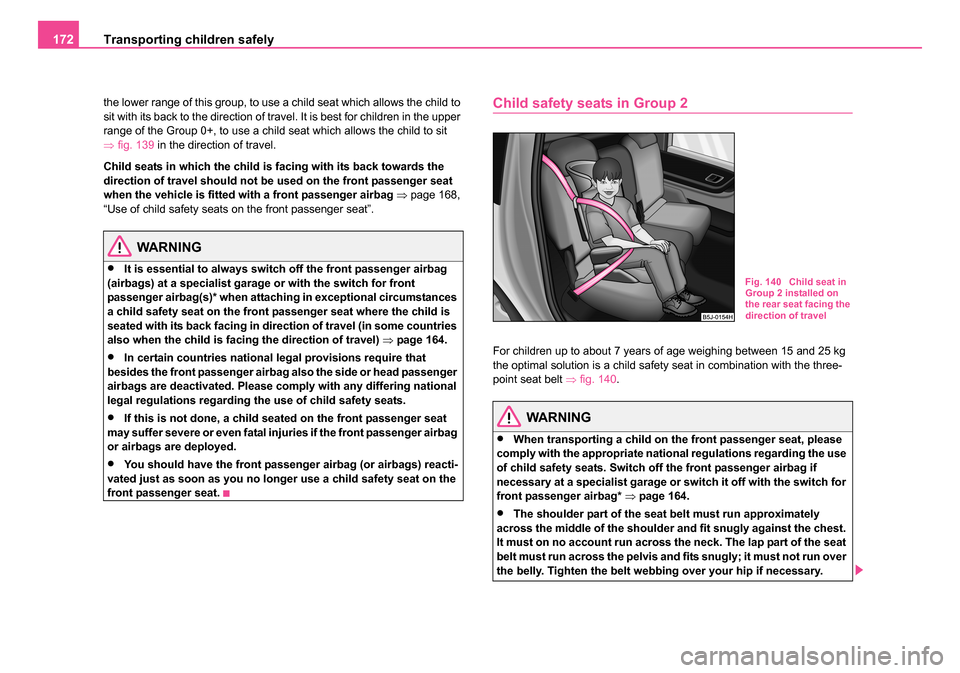2006 SKODA ROOMSTER belt
[x] Cancel search: beltPage 157 of 274

Airbag system
156
− The interior lighting comes on (if the switch for the interior light is in
the door contact position),
− The hazard warning light is switched on,
− All the doors are unlocked.
Front airbags
Description of the front airbags
The airbag system is not a substitute for the seat belt!
The front airbag for the driver is housed in the steering wheel ⇒fig. 125 .
The front airbag for the front passenger* is housed in the dash panel
above the storage compartment ⇒fig. 126 . The installation positions are
each marked with the “AIRBAG” logo.
The front airbag system is complementary to the three-point seat belts
and offers additional protection in the head and chest area of the driver
and passenger in the event of a frontal collision ⇒ in “Important safety
information regarding the front airbag system” on page 158.
The airbag is not a substitute for the seat belt, but is part of the complete
passive vehicle safety concept. Please note that an airbag can only
offer you optimal protection in combination with a seat belt which is
fastened .
Apart from their normal protective function, a further task of the seat belts
is to also hold the driver and front passenger in a correct seated position
in the event of a frontal collision so as to enable the front airbags to offer
the maximum protection.
Fig. 125 Driver airbag
in the steering wheel
Fig. 126 Front
passenger airbag in the
dash panel
NKO 20 A05.book Page 156 Wednesday, June 21, 2006 1:42 PM
Page 158 of 274

Airbag system157
Using the systemSafetyDriving TipsGeneral MaintenanceBreakdown assistanceTechnical Data
You should therefore always fasten the seat belts, not only because this
is required by law, but also for safety reasons and for your own protection
⇒
page 147, “Why seat belts?”.
Caution
The dash panel must be replaced after the front passenger airbag has
been deployed.
Function of the front airbags
Risk of injury to the head and chest area is reduced by fully
inflated airbags.
The airbag system is designed in such a way that the driver and front
passenger airbag* are deployed in the event of a frontal collision of major
severity. In certain accident situations both the front airbags as well as the head
and side airbags may be deployed together.
If the airbags are deployed, the airbags are filled with a propellant gas and
inflated in front of the driver and front passenger
⇒fig. 127 . The airbags
inflate in fractions of a second and at a high speed in order to be able to
offer that additional protection in the event of an accident. The forward
movement of the driver and of the front passenger is cushioned when they
make contact with the fully inflated airbag and the risk of injury to head and
chest is thus reduced.
The specially developed airbag allows the gas to flow out of the inflated
airbag in a controlled manner (depending on the load of the particular car
occupant) in order to cushion head and chest areas. The airbag then
deflates subsequently to such an extent, after an accident, to again
provide a clear view forward.
A grey white, non harmful gas is released when airbag is inflated. This is
perfectly normal and is not an indication of a fire in the vehicle.
The airbag develops enormous forces when triggered, which can lead to
injuries if the sitting position or seated position is not correct ⇒ in
“Important safety information regarding the front airbag system”.
Fig. 127 Inflated
airbags
NKO 20 A05.book Page 157 Wednesday, June 21, 2006 1:42 PM
Page 160 of 274

Airbag system159
Using the systemSafetyDriving TipsGeneral MaintenanceBreakdown assistanceTechnical Data
Side airbags*
Description of side airbags
The side airbag increases protection of the passenger
concerned in the case of a side impact.
The side airbags are housed in the upholstery of the backrests of the front
seats and are marked ⇒fig. 129 with the lettering “AIRBAG” on the
middle part.
The side airbag system in combination with the three-point seat belts,
offers additional protection for the upper area of the body (chest, stomach
and pelvis) in the event of severe side collisions ⇒ in “Important safety
information on the side airbag” on page 160.
Apart from their normal protective function, a further task of the seat belts
is to also hold the driver and front passenger in a correct seated position
in the event of a side collision so as to enable the side airbags to offer the
maximum protection. You should therefore always fasten the seat belts, not only because this
is required by law, but also for safety reasons and for your own protection
⇒
page 147, “Why seat belts?”.
Function of the side airbags
Risk of injury to the upper part of the body is reduced by
fully inflated side airbags.
In the case of a violent side crash , the side airbags in the front seat and
the head airbags on the side of the car at which the collision occurs, are
deployed ⇒fig. 130 .
In certain accident situations both the front airbags as well as the head
and side airbags may be deployed together.
If an airbag is deployed, the airbag is filled with propellant gas. The
airbags inflate in fractions of a second and at a high speed in order to be
able to offer that additional protection in the event of an accident.
Fig. 129 Driver seat:
Installation position of
airbag
Fig. 130 Side airbags
deployed
NKO 20 A05.book Page 159 Wednesday, June 21, 2006 1:42 PM
Page 162 of 274

Airbag system161
Using the systemSafetyDriving TipsGeneral MaintenanceBreakdown assistanceTechnical Data
Head airbags*
Description of the head airbags
The head airbag together with the side airbag offers
enhanced occupant protection in the event of a side colli-
sion.
The head airbags are positioned above the doors on both sides in the inte-
rior of the car ⇒page 161, fig. 131 . The installation positions of the head
airbags are each marked with the “AIRBAG” logo.
The head airbag together with the three-point seat belts and the side
airbags, offers additional protection for the head and neck area of the
occupants in the event of a side collision of major severity ⇒ in “Impor-
tant safety information on the head airbag” on page 162.
Apart from their normal protective function, a further task of the seat belts
is to also hold the driver and the occupants in a correct seated position in the event of a side collision so as to enable the head airbags to offer the
maximum protection.
You should therefore always fasten the seat belts, not only because this
is required by law, but also for safety reasons and for your own protection
⇒
page 147.
Together with other elements (such as cross bars in the seats, stable
vehicle structure) the head airbags are the consequent further develop-
ment of occupant protection in the case of side collisions.
Function of the head airbags
The risk of injury to the head and neck area is reduced in
the event of a side collision by fully inflated head airbags.
In the case of a side collision the head airbag is deployed together with
the relevant side airbag on the side of the car on which the accident occurs
⇒ fig. 132 .
Fig. 131 Installation
position of the head
airbags
Fig. 132 Inflated head
airbag
NKO 20 A05.book Page 161 Wednesday, June 21, 2006 1:42 PM
Page 167 of 274

Transporting children safely
166
Transporting children safely
What you should know about
transporting children!
An introduction to the subject
Accident statistics have revealed that children are gener-
ally more safely transported on the rear seats than on the
front passenger seat.
Children younger than 12 years of age should normally travel on the rear
seat of the vehicle (take note of any national legal provisions which differ
from this). They should be secured there by means of a child restraint
system or by using the existing seat belts depending on their age, body
size and weight. The child seat should be mounted behind the front
passenger seat for safety reasons.
The physical principle of an accident does, of course, also apply to chil-
dren ⇒page 148, “The physical principle of a frontal collision”. They differ
from adults in that their muscles and bone structure of children are not yet
fully developed. Thus children are exposed to increased risk of injury.
Children should be transported by using special child safety seats in order
to reduce this risk of injury.
Only use child safety seats which are officially approved, suitable for chil-
dren and which comply with the ECE-R 44 standard, which classifies child
safety seats into 5 groups ⇒page 170, “Classification of child seats into
groups”. Child restraint systems which have been tested for conformity
with ECE-R 44 have a non-detachable test seal (a large E within a circle
and below this the test number) attached to the seat. We recommend that you use child safety seats from the Škoda genuine
accessories. These child seats were developed and also tested for use in
Škoda vehicles. They fulfil the standard ECE-R 44.
WARNING
Always comply with national le
gal provisions and instructions
from the relevant child safety seat manufacturer when installing
and using a child seat ⇒ in “Important safety information
regarding the use of child safety seats”.
Note
Any national legal provisions which vary from the information contained in
this Owner's Manual take precedence over the information contained
herein.
Important safety informatio n regarding the use of
child safety seats
Correct use of child safety seats considerably reduces the
risk of injury!
WARNING
•All the occupants of the car - in particular children - must wear
a seat belt when the car is moving!
•Children less than 1.50 m in height or younger than 12 years
must not use a normal seat belt without a child restraint system
NKO 20 A05.book Page 166 Wednesday, June 21, 2006 1:42 PM
Page 168 of 274

Transporting children safely 167
Using the systemSafetyDriving TipsGeneral MaintenanceBreakdown assistanceTechnical Data
otherwise this may result in injuries to the stomach and neck areas.
Comply with the national legal requirements.
•One should never carry children, and also not babies! - on one's
lap.
•You can transport a child safely in a suitable child safety seat
⇒ page 170, “Child seat”!
•Only one child may be fastened with a seat belt into a child
safety seat.
•Never leave the child sitting unattended in the seat.
•Certain outside climatic conditions can cause life-threatening
temperatures in the vehicle.
•Never allow your child to be tran sported in a vehicle without the
use of a suitable restraint system.
•Children should also never stand up in a vehicle or kneel on the
seats when the vehicle is moving. In the event of an accident the
child will be thrown through the vehicle and may as a result suffer
fatal injuries, and also injure other occupants.
•Children are exposed to an increased risk of injury in the event
of an accident if they lean forward or adopt an incorrect seated
position when the vehicle is moving . This particularly applies to
children who are transported on the front passenger seat if the
airbag system deploys in the event of an accident. This can result
in severe or even fatal injuries.
•It is important that the belt webb ing is properly routed if the seat
belts are to offer their maximum protection ⇒page 150, “How are
seat belts correctly fastened?”. Pay particular attention to the infor-
mation provided by the manufacturer of the child safety seat
regarding correct routing of the belt. Seat belts which are not
correctly adjusted can themselves cause injuries even in minor
accidents.
•Safety belts must be checked to ensure that they are running
properly. One should also ensure that the belt is not damaged by
sharp-edged fittings.
•It is essential to always switch off ⇒page 163 the front
passenger airbag when attaching a child safety seat on the front
passenger seat where the child is seated with its back facing in
direction of travel (in some countries also when the child is facing
the direction of travel). If this is not done, there is a risk of the child
suffering severe or even fatal injuries if the front passenger airbag
is deployed. In certain countries national legal provisions also
require that the side or head passenger airbags be deactivated.
When transporting a child on the front passenger seat, please
comply with the appropriate national regulations regarding the use
of child safety seats.
WARNING (continued)WARNING (continued)
NKO 20 A05.book Page 167 Wednesday, June 21, 2006 1:42 PM
Page 171 of 274

Transporting children safely
170
•Do not place any objects within the deployment area of the side
airbag - risk of injury!
Child seat
Classification of child seats into groups
Only child safety seats which have an official approval and
are suitable for the child, may be used.
ECE-R 44 standard applies to child safety seats. ECE-R means:
Economic Commission of Europe - Regulation.
Child safety seats which have been tested for conformity with ECE-R 44
have a non-detachable test seal (a large E within a circle and below this
the test number) attached to the seat.
Child safety seats are classified in 5 groups:
Children of more than 150 cm in height may use the seat belts fitted to the
vehicle without a seat bolster.
Use of child seats
An overview of the usefulness of child seats on each of the seats
according to the EG guidelines 77/541 and ECE 44 standard:
Universal category - seat is suitable for all approved types of child
safety seats.
The seat can be fitted with fixing eyes for the “ ISOFIX*”system.
The seat is equipped as standard with the fixing system “ Top
Te t h e r ”.
GroupWeight
00 - 10 kg⇒page 171
0+up to 13 kg⇒page 171
19 - 18 kg⇒page 171
215 - 25 kg⇒page 172
322 - 36 kg⇒page 173
WARNING (continued)
Child seat
according to
groupFront passenger seatRear seatoutsideRear seat middle
0
0+
1
2 and 3
AUAUA+ATAU
AUAUA+ATAU
AUAUA+ATAU
AUAUAU
AU
A+
AT
NKO 20 A05.book Page 170 Wednesday, June 21, 2006 1:42 PM
Page 173 of 274

Transporting children safely
172
the lower range of this group, to use a child seat which allows the child to
sit with its back to the direction of travel. It is best for children in the upper
range of the Group 0+, to use a child seat which allows the child to sit
⇒ fig. 139 in the direction of travel.
Child seats in which th e child is facing with its back towards the
direction of travel should not be used on the front passenger seat
when the vehicle is fitted with a front passenger airbag ⇒ page 168,
“Use of child safety seats on the front passenger seat”.
WARNING
•It is essential to always switch off the front passenger airbag
(airbags) at a specialist garage or with the switch for front
passenger airbag(s)* when attaching in exceptional circumstances
a child safety seat on the front passenger seat where the child is
seated with its back facing in direction of travel (in some countries
also when the child is facing the direction of travel) ⇒page 164.
•In certain countries national legal provisions require that
besides the front passenger airbag also the side or head passenger
airbags are deactivated. Please comply with any differing national
legal regulations regarding the use of child safety seats.
•If this is not done, a child seated on the front passenger seat
may suffer severe or even fatal injuries if the front passenger airbag
or airbags are deployed.
•You should have the front passenger airbag (or airbags) reacti-
vated just as soon as you no longer use a child safety seat on the
front passenger seat.
Child safety seats in Group 2
For children up to about 7 years of age weighing between 15 and 25 kg
the optimal solution is a child safety seat in combination with the three-
point seat belt ⇒fig. 140 .
WARNING
•When transporting a child on the front passenger seat, please
comply with the appropriate national regulations regarding the use
of child safety seats. Switch off the front passenger airbag if
necessary at a specialist garage or switch it off with the switch for
front passenger airbag* ⇒page 164.
•The shoulder part of the seat belt must run approximately
across the middle of the shoulder and fit snugly against the chest.
It must on no account run across the neck. The lap part of the seat
belt must run across the pelvis and fits snugly; it must not run over
the belly. Tighten the belt webbing over your hip if necessary.
Fig. 140 Child seat in
Group 2 installed on
the rear seat facing the
direction of travel
NKO 20 A05.book Page 172 Wednesday, June 21, 2006 1:42 PM